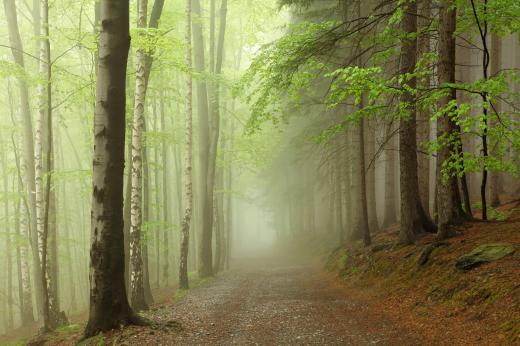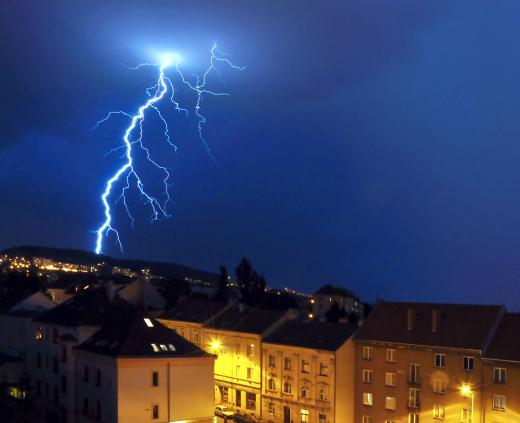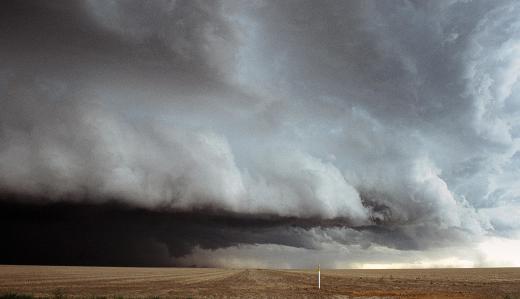What Is a Warm Front?
 Jessica Ellis
Jessica Ellis
A warm front is a meteorological phenomenon that occurs when a mass of warm air bulges out against a mass of cooler air. This transitional zone marks the boundary between warm and cool air masses, and is sometimes associated with inclement weather. Although a warm front may sound like a harbinger of sunny days, it can actually bring rain, fog, and thunderstorms for several days.
Warm air is more moist than cool air, and tends to move slower than cool air masses. When a warm mass flows into a cool mass, the heated air tends to rise above the cold air, allowing the heavy moisture content to condense into clouds as it passes through the colder air. The condensation and mixture process produces clouds, which can result in a variety of weather changes, including heavy fog, rainstorms, thunderstorms, and snow.

The weather preceding warm fronts is generally associated with cooler temperatures, which may be clear or occur with drizzle, showers, or snow. As cloud cover increases when the warm front moves in, skies may become cloudy, humidity generally rises, and storms or fog may occur. Once the front has passed, temperatures will warm, precipitation levels off, and skies often clear until the next front appears.

Warm fronts can be quite massive in scale, covering several hundred miles in some cases. If an entire region experiences a period of storms followed by warming temperatures and clearing skies, it is generally the result of a massive warm front having passed through the entire area. Since cold air may take a while to retreat behind the encroaching warm air mass, stormy or cloudy conditions at the boundary of a warm front may last for hours, days, or weeks, and can bring variable weather patterns.

Wind directions are also affected by the movement of warm fronts. Before a warm front reaches an area, winds typically blow from south to southeast in the northern hemisphere, or north to northeast in the southern hemisphere. As the front reaches an area, winds can become variable in direction and speed. Once the turbulent transition zone has passed and the warm air mass moves into an area fully, wind direction in the northern hemisphere often become south/southwest. In the southern hemisphere, wind direction shifts to north/northwest.
Most meteorological charts depict a warm front by using a red line marked with half circles. The half circles indicate the leading edge of the front and its direction. A stationary front consists of a warm air mass that is up against a cool air mass, but not strong enough to overtake it as a warm front. This boundary is typically marked on charts as a red and blue line with alternating half-circles and triangles.
AS FEATURED ON:
AS FEATURED ON:













Discussion Comments
What scares me most about the conditions that can be produced by warm fronts is the wind speeds. When I was little, I was staying with my aunt one night and a storm came up. The wind was loud and we heard several loud noises during the night.
When we went outside the next morning there were several large trees lying in the yard. The wind had removed them from the ground, and the roots were totally exposed.
Assuming that I am out of the weather and in a safe building, I really enjoy watching thunderstorms. The loud noises can be a bit frightening, but I really like the way the lightning lights up the sky. To me, this is like a fourth of July fireworks show, but better because you can feel the power of the storm all around you.
Again, I know these storms have the potential to be dangerous, but they are still amazing to watch. It gives me even more respect for nature and all the forces of nature when I watch them.
I grew up in an area that was known for having tornadoes. There were certain times of the year when you could expect to see them or hear about them popping up. Even the youngest of kids knew that when you were having cold weather and a warm front was moving in or when it was hot and a cold front was moving in there was probably going to be some exciting and dangerous weather in the forecast.
When I was kid, I liked to watch the weather report so I could tell my parents what the weather was going to be like in the coming days. I was unaware at the time exactly what a warm front or a cold front was, but I assumed that a warm front meant warm weather was coming and of course a cold front meant cold weather was headed our way. This seemed simple enough to me at the time.
Post your comments